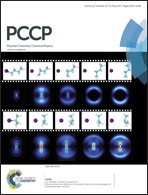A dynamic study of the structural change in the binary network in response to guest inclusion†
Abstract
In the present work flexible binary networks of 1,3,5-benzenetricarboxylic acid (TMA) with 4,4′-bipyridine (Bpy) or 1,3,5-tris(4-pyridyl)-2,4,6-triazine(TPTZ) molecules at the liquid–solid interface were constructed. When coronene (COR) molecules are introduced into these systems, the binary networks collapse and at the same time, new COR/TMA host–guest structures are formed. Both experiments and calculations unambiguously indicate that the COR/TMA host–guest complex structure has stronger adsorption energy, resulting in the deconstruction–reconstruction phenomenon.


 Please wait while we load your content...
Please wait while we load your content...